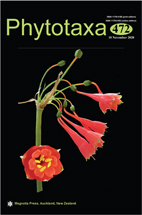Abstract
During the study of Usnea from China, we identified and illustrated a new species, Usnea sulphuridiscoidea S. Y. Guo & L. F. Han from the Ailaoshan Mountain of Southwest China, based on morphological characteristics and nrDNA ITS sequence data. This new species can be distinguished morphologically from other apotheciate members of Usnea by the special lateral apothecia with sulphur disc, the inflated branches with glossy surface and numerous papillae as well as many fibrils, meanwhile lacking pseudocyphellae and soralia. The nrDNA ITS sequence data supported the recognition of the new species.
References
<a href="https://doi.org/10.11646/bde.17.1.12">https://doi.org/10.11646/bde.17.1.12</a>
Aptroot, A., Sparrius, L.B. & Lai, M.J. (2002) New Taiwan macrolichens. Mycotaxon 84: 281–292.
Awasthi, D.D. (1961) Some foliose and fruticose lichens from assam and north-east frontier agency of India. Proceedings of the Indian Academy of Sciences-Section B 54: 24–44.
Clerc, P. (1984) Contribution à la revision de la systém atique des usnées (Ascomycotina, Usnea) d?Europe. I.–Usnea florida (L.) Wigg. emend. Clerc. Cryptogamie Bryologie et Lichénologie 5: 333–360.
Clerc, P. (1998) Species concepts in the genus Usnea (1ichenized Ascomycetes). Lichenologist 30: 321–340.
<a href="https://doi.org/10.1006/lich.1998.0150">https://doi.org/10.1006/lich.1998.0150</a>
Clerc, P. (2004) Notes on the genus Usnea Adanson. II. Bibliotheca Lichenologica 88: 79–80.
<a href="https://www.researchgate.net/publication/258331156">https://www.researchgate.net/publication/258331156</a>
Clerc, P. & Herrera-Campos, C.M.A. (1997) Saxicolous Species of Usnea Subgenus Usnea (Lichenized Ascomycetes) in North America. The Bryologist 100: 281–301.
<a href="https://doi.org/10.1639/0007-2745(1997)100%5b281:SSOUSU%5d2.0.CO;2">https://doi.org/10.1639/0007-2745(1997)100[281:SSOUSU]2.0.CO;2</a>
Crespo, A., Lumbsch, H.T., Mattsson, J.E., Blanco, O., Divakar, P.K., Articus, K., Wiklund, E., Bawingan, P.A. & Wedin, M. (2007) Testing morphology-based hypotheses of phylogenetic relationships in Parmeliaceae (Ascomycota) using three ribosomal markers and the nuclear RPB1 gene. Molecular Phylogenetics and Evolution 44: 812–824.
<a href="https://doi.org/10.1016/j.ympev.2006.11.029">https://doi.org/10.1016/j.ympev.2006.11.029</a>
Dodge, C.W. (1956) Some lichens of Tropical Africa. II. Usnea. Annals of the Missouri Botanical Garden 43: 381–396.
<a href="https://doi.org/10.2307/2394558">https://doi.org/10.2307/2394558</a>
Han, L.F., Xu, X.M., Yang, J.Y. & Guo S.Y. (2018) Peltigera neodegenii sp. nov. from Central China. Mycotaxon 133: 323–332.
<a href="https://doi.org/10.5248/133.323">https://doi.org/10.5248/133.323</a>
Herrera-Campos, M.A., Clerc, P. & Nash, T.H.III. (1998) Pendulous species of Usnea from the temperate forests in Mexico. The Bryologist 101: 303–329.
<a href="https://doi.org/10.2307/3244208">https://doi.org/10.2307/3244208</a>
Kumar, S., Stecher, G., Li, M., Knyaz, C. & Tamura, K. (2018) MEGA X: Molecular evolutionary genetics analysis across computing platforms. Molecular Biology and Evolution 35: 1547–1549.
<a href="https://doi.org/10.1093/molbev/msy096">https://doi.org/10.1093/molbev/msy096</a>
Lamb, I.M. (1964) British Antarctic survey scientific reports 38: Antarctic lichens. The British Antarctic Survey, London, 87 pp.
Li, S., Liu, W.Y., Wang, L.S., Yang, G.P. & Li, D.W. (2007) Species diversity and distribution of epiphytic lichens in the primary and secondary forests in Ailao Mountain, Yunnan. Biodiversity Science 15: 445–455.
<a href="https://doi.org/10.1360/biodiv.070078">https://doi.org/10.1360/biodiv.070078</a>
Lücking, R., Hodkinson, B.P. & Leavitt, S.D. (2016) The 2016 classification of lichenized fungi in the ascomycota and basidiomycota—approaching one thousand genera. The Bryologist 119: 361–416.
<a href="https://doi.org/10.1639/0007-2745-119.4.361">https://doi.org/10.1639/0007-2745-119.4.361</a>
Ohmura, Y. (2001) Taxonomic study of the genus Usnea (lichenized Ascomycetes) in Japan and Taiwan. Journal of the Hattori Botanical Laboratory 90: 1–96.
Ohmura, Y. (2008) Taxonomy and molecular phylogeny of Usnea rubicunda and U. rubrotincta (Parmeliaceae, lichenized Ascomycotina) based on ITS rDNA sequences. Journal of Japanese Botany 83: 347–355.
Ohmura, Y. (2012) A synopsis of the lichen genus Usnea (Parmeliaceae, Ascomycota) in Taiwan. Memoires National Museum Natural Sciences 48: 91–137
Ohmura, Y., Lin, C.K. & Wang, P.H. (2010) Three sorediate species of the genus Usnea (Parmeliaceae, Ascomycota) new to Taiwan. Memoirs of the National Museum of Nature Science 46: 69–76.
Orange, A., James, P.W. & White, F.J. (2010) Microchemical methods for the identification of lichens. 2nd Edition. British Lichen Society, London, 101 pp.
Rana, K., Nayaka, S., Shukla, P. & Upreti, D.K. (2015) Notes on occurrence of fruticose lichens in JoramTop, ZiroValley, Arunachal Pradesh with 10 new records to the state. International Journal of Science and Research (IJSR) 4: 5–611.
<a href="https://doi.org/10.21275/v4i12.NOV152355">https://doi.org/10.21275/v4i12.NOV152355</a>
Randlane, T., Tõrra, T., Saag, A. & Saag, L. (2009) Key to European Usnea species. Bibliotheca Lichenologica 100: 419–462.
<a href="https://www.researchgate.net/publication/228476960">https://www.researchgate.net/publication/228476960</a>
Saag, L., Tõrra, T., Saag, A., Del-Prado, R. & Randlane, T. (2011) Phylogenetic relations of European shrubby taxa of the genus Usnea. Lichenologist 43: 427–444.
<a href="https://doi.org/10.1017/S0024282911000375">https://doi.org/10.1017/S0024282911000375</a>
Seaward, M.R.D. & Aptroot, A. (2005) Hong Kong lichens collected on the United States North Pacific exploring expedition, 1853-1856. The Bryologist 108: 282–286.
<a href="https://doi.org/10.1639/0007-2745(2005)108%5b0282:HKLCOT%5d2.0.CO;2">https://doi.org/10.1639/0007-2745(2005)108[0282:HKLCOT]2.0.CO;2</a>
Shukla, P.U., Preti, D.K. & Tewari, L.M. (2014) Lichen genus Usnea (Parmeliaceae, Ascomycota) in Uttarakhand, India. Current Research in Environmental & Applied Mycology 4 (2): 188–201.
<a href="https://doi.org/10.5943/cream/4/2/6">https://doi.org/10.5943/cream/4/2/6</a>
Tamura, K. & Nei, M. (1993) Estimation of the number of nucleotide substitutions in the control region of mitochondrial DNA in humans and chimpanzees. Molecular Biology and Evolution 10: 512–526.
<a href="https://doi.org/10.1093/oxfordjournals.molbev.a040023">https://doi.org/10.1093/oxfordjournals.molbev.a040023</a>
Truong, C. & Clerc, P. (2016) New species and new records in the genus Usnea (Parmeliaceae, lichenized Ascomycota) from tropical South America. Lichenologist 48: 71–93.
<a href="https://dx.doi.org/10.1017/S0024282915000419">https://dx.doi.org/10.1017/S0024282915000419</a>
Truong, C., Rodriguez, J.M. & Clerc, P. (2013) Pendulous Usnea species (Parmeliaceae, lichenized Ascomycota) in tropical South America and the Galapagos. Lichenologist 45: 505–543.
<a href="https://doi.org/10.1017/S0024282913000133">https://doi.org/10.1017/S0024282913000133</a>
Wei, J.C. (1991) An enumeration of lichens in China. International academic publishers, Beijing, 278pp.
White, T.J., Bruns, T.D., Lee, S.B. & Taylor, J.W. (1990) Amplification and direct sequencing of fungal ribosomal RNA genes for phylogenetics. In: Innis, M.A., Sninsky, D.H. & White, T.J. (Eds.) PCR Protocols–a guide to methods and applications. Academic Press, San Diego, pp. 315–322.
<a href="https://doi.org/10.1016/B978-0-12-372180-8.50042-1">https://doi.org/10.1016/B978-0-12-372180-8.50042-1</a>
Zhang, T., Li, H.M. & Wei, J.C. (2006) The lichens of Mt. Fanjingshan in Guizhou province. Journal of Fungal Research 4: 1–13.
<a href="https://doi.org/10.3969/j.issn.1672-3538.2006.01.001">https://doi.org/10.3969/j.issn.1672-3538.2006.01.001</a>
Zhao, J.D., Hsu, L.W. & Sun, Z.M. (1982) Prodromus Lichenum Sinicorum. Science Press, Beijing, 156 pp.

